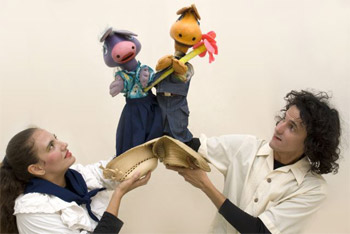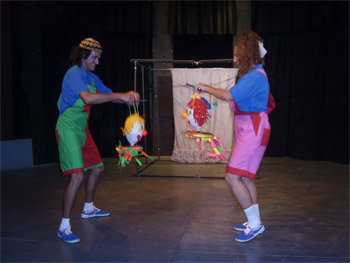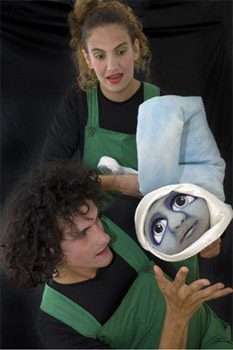A Cuban Puppeteer Couple and their Traveling Theater
Helson Hernandez

HAVANA TIMES – “Doing theater these days, and in this world, might seem utopian,” said Leobaldo, of the group Teatro Viajero (Traveling Theater). “Teatro Viajero is based on one essential perspective: approaching theater as a journey,” notes Carmela in their interview with Havana Times.
HT: Why “Teatro Viajero” (Traveling Theater)?
Carmela: First of all, it was a point of agreement between the members, a meeting of similarities, our common taste and desire “to travel.” The name implies movement, with motion as an aim. In turn, the characteristics that define travel have stories and particularities belonging to each traveler.
In my case it involved the story of me as a little girl riding on a train with all my dolls, as if they were my children, it seemed like an eternity that was somewhat sad and lonely, but I really enjoyed the travel and the landscapes along the way.
Leobaldo: My existence has always been marked by travel, my need to move. I have a restless temperament that expresses itself in a strong desire to explore…to know. I was born in Havana and when I was around five we moved to live to Santiago de Cuba. From that moment on, my life was characterized by back and forth movement between those two cities. What truly made me happy were my two utopias: family meetings and shared stories.
C: Teatro Viajero is based on one essential perspective: approaching theater as a journey. This can be understood as a process that comes from within ourselves and that consciously explores new forms of expression in the search for a language that allows us to communicate with real-life human beings.
HT: Has it been difficult in your case to widely project yourselves as your name implies, as “travelers”?
L: Yes. Any journey involves risk, as it’s one’s very being that’s at stake. You need not only spirituality, but to also depend on reality to a great extent. That’s something that will always be difficult as you find more than one obstacle to overcome in trying to make your dreams flow. Doing theater these days, and in this world, may seem utopian, and even more so when you define yourself as a “traveler.”
C: Breaking the boundaries is the most difficult. Freedom and creation begin to feel limited, both out of material needs, which start with from one’s very subsistence, to the many misunderstandings and intolerances that crop up along your path.
These often end up getting in the way. But we continue traveling, always traveling, despite the form of transportation, tickets, visas, letters of invitation… The challenge will continue to be our managing to create and remaining true to our principles and premises.
HT: Where do the members of Traveling Theater come from?
C: I graduated from the Superior Institute of Art specializing in playwriting, and I entered the world of puppets after a literary journey that allowed me to meet with masters and creators of this specialty. I was really fascinated to discover so many expressive possibilities in puppetry. We created the group and began our journey. I began as the director and later contributed as an actress and a playwright.

L: I came to the world of theater for children and puppets in a rare act of lucidity experienced in adolescence. A group of friends and I decided to create a program directed towards children in which “Pinocchio,” the character I played, was the leading figure. This allowed me to find my way and decide where I wanted to go in connection with the humor and innocence. My background is mostly practical, but I always linked learning to great teachers of acting, pantomime and puppetry. Today I’m a mid-level graduate specializing in children’s theater and puppetry.
HT: Is it a tradition among Cuban puppeteers to create groups made up of family members?
L: It’s not something that completely characterizes the Cuban puppetry scene, though there have been cases of this. A milestone of puppet theater in Cuba was the group “Los Hermanos Camejo,” creators of the Guinol Nacional (the National Puppet Theater) and the various puppet companies that exist across the country.
The metaphor “puppeteer family” fits well with groups that specialize in theater. It’s more common to see this tradition in some Latin American countries, where families or couples just like us have decided to join in their lives and in their careers.
C: In the Cuba of the 1990’s, a period characterized by a deep economic crisis, there began to emerge theater projects that consisted of partners and married couples. These constituted almost the main creative units of the movement because of the expressive possibilities and the synthesis of resources these allowed.
Although this phenomenon isn’t seen as often today, in our case the theater has also been the cause for the creation of a “traveling family,” with the addition of our little son – and we hope there will be more little ones who will join us in our journey.
HT: What defines Teatro Viajero aesthetically?
C: Before anything else there’s the relationship established between the physical presence of the actor and the animated figure.
L: To this we should add that we start with detailed and thorough research, managing even to create our own techniques, such as using puppets with elastic threads and rattling puppets, among the other techniques that distinguish us from the rest of the groups on the island.
HT: From the international experiences that the group has had, what have been your most rewarding?
C: Although there haven’t been as many as we would like, what stands out was our participation in the 2010 Seventh World IDEA Congress and Theatre Festival, held in Brazil. There, we met intellectuals and artists from 70 countries. Representatives from all continents were there celebrating diversity and coming together as different cultures in that effort to promote theater and art education as tools for social transformation.
This experience allowed us to meet and share with people from around the world through our language known as “puppetry.” It was like traveling to many countries at once. We were pleased to be included in the opening ceremony of the congress as representatives of Latin America, together with expressions of the indigenous peoples of Brazil, all integrated into a truly exciting spectacle.
The rest of the experience included more than fifteen presentations in the city of Belen, in the state of Para, on the edge of the Amazon. Participation in this world congress allowed us to discover the value, strength and wealth of art we do.
HT: What can you say about the future of puppetry in Cuba and the new generation of artists involved in that specialty?
L: The future of puppetry in Cuba depends on that future generation, its interest, its ability to deepen and contextualize an art form that is inherent in human beings and that has survived along with us throughout all the vicissitudes of our evolution.
It’s up to us to keep fanning the flame so this beam of light doesn’t go out, one that has baffled so many beings. I think that so far we earthlings are the only beings who have created puppets in this galaxy, and that’s a godsend.

HT: In an era in which new technologies are so important, it’s interesting to see how puppetry still prevails.
C: Absolutely. This is due mainly to puppetry being an art of the arts, one in which we combine all art forms to project — simply and in a synthesis — a great metaphor of senses. So far, the new technologies haven’t been an impediment to the expression of puppeteers; on the contrary, puppeteers have shown themselves able to adopt, nurture and re-dimension them.
Their artisanal nature lends them a ductile essence that is so very close to human creation, which is what allows them to maintain their identity and survive the test of time.
HT: What do you plan as your next stage performance as Teatro Viajero?
C: Teatro Viajero is engaged in the realization of a dream: “El viaje del caracol” (The March of the Snail). This year we’re marking our thirteenth anniversary since our founding and we want to celebrate this with the debut of this work. It’s my version of a beautiful poem by Federico Garcia Lorca, “Los encuentros de un caracol aventurero” (Encounters of a Snail Adventurer).
Although the journey has been long, slow and diffused… the process has been a great school for us. Our rigor and our desire for perfection have led us to constantly improve ourselves, to return from chaos again and again to where creation is organized in a unique and compelling manner.
If this is achieved, the journey will have made it to a central station. From this necessary and urgent stop along the way we can catch our breath and then continue the course set by the travelers.





